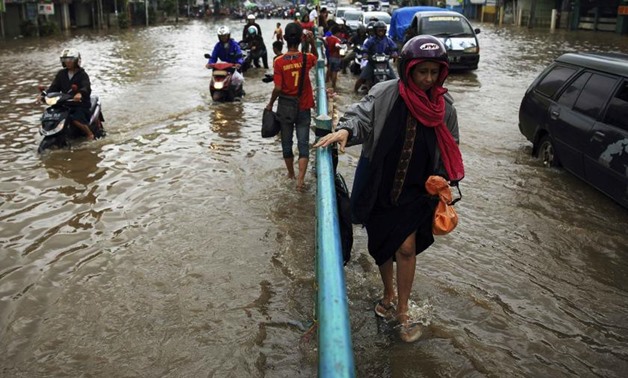
A woman holds a street divider as she walks through a flooded street in Jakarta, January 24, 2014 - Reuters
KUALA LUMPUR - 24 November 2017: Aida Widyawati boards a commuter train each day to travel from her home in South Tangerang, west of Jakarta, to her job as an office manager in the center of Indonesia’s capital. The 120-km (75-mile) round trip takes three and a half hours on a good day.
Last month, the mother-of-two sprained both ankles falling down some stairs at home and was forced to take a taxi to work. Her total journey time rose to six hours. In the monsoon season, her commute time can easily double.
“It is very boring,” said Widyawati, who tries to catch up on sleep during her travels to work. “I just hope that the government will one day offer a better service.” Widyawati is one of more than 5 million people struggling to get to work each day in Southeast Asia’s largest city.
Known as the “Big Durian” after the stinky fruit popular in the region, Greater Jakarta is home to about 25 million people and faces numerous challenges due to rapid urbanization, climate change and the failure of infrastructure and public transport to keep pace with its expansion.
In addition to its infamous congestion - which is often cited by traffic studies as the worst in the world, and costs the city an estimated $3 billion per year - Jakarta also suffers from water scarcity, poor sanitation, regular flooding, air pollution and a lack of affordable housing.
Last year the mega-city joined 100 Resilient Cities, a network backed by The Rockefeller Foundation to help cities deal with 21st century pressures.
The Resilient Jakarta Secretariat, set up this September, has since brought together government officials, researchers, businesses and citizens’ groups to map the city and pinpoint issues that will be outlined in a first report due to be published in two weeks.
Oswar Mungkasa, Jakarta’s chief resilience officer, told the Thomson Reuters Foundation his city has at least three major problems: transportation, flooding and land subsidence.
STUCK IN A JAM
Vehicle emissions, made worse by Jakarta’s jams, account for 70 percent of air pollution in the city. Besides the economic costs and negative effects on quality of life, the pollution puts extra pressure on public health services. But in a city where pedestrians and motorcyclists often face off over the use of ramshackle pavements, some steps are being taken to help ease congestion.
Construction of the $3-billion Jakarta Mass Rapid Transit (MRT) railway began in 2013, and it is likely to be up and running by 2019, when a light rail transit is also due to open. “We are trying to solve the problem,” Mungkasa said. “In two or three years after the MRT (is built), the situation will be much, much better.”
Jakarta has also implemented an odd-even license plate policy for key roads to limit private car use in busy hours, while many residents have embraced motorcycle taxi apps in an effort to beat jams.
Critics note, however, that the MRT project will only connect South Jakarta to the city center, and will therefore not be a silver bullet to cure chronic traffic problems.There are also questions over whether the new train networks will be integrated with existing public transport, like the TransJakarta bus rapid transit system.
The city must develop a “push-pull strategy” to discourage private vehicles while incentivizing public transport use, said Shobhakar Dhakal, head of the energy, environment and climate change department at the Asian Institute of Technology (AIT).
“But without giving proper options it doesn’t work,” he said, adding Jakarta should have built a metro train system two decades ago.
THAT SINKING FEELING
A coastal city built on a swampy plain, roughly 40 percent of Jakarta is below sea level. Making matters worse, most residents and businesses rely on wells that drain underground aquifers for their water supplies, resulting in the city sinking by 5-10 cm each year.
Rising sea levels and the inability of crumbling infrastructure to cope with excess water during heavy storms and the monsoon season result in regular flooding. Resilient Jakarta’s report will ask how health and wellbeing can be improved through better water and waste management.
The city is working hard to solve these problems, said Mungkasa, with improvements to water infrastructure, including the piped supply, and new waste water treatment facilities set to be built over the next 20 years.
Jakarta’s piped water network needs to be expanded to both poor and wealthy neighborhoods, said Marcus Lee, a senior urban economist at the World Bank in Jakarta. Because well water is free and often seen as cleaner, the government must also enforce piped water usage where accessible, he added.
The city’s slums - many located on land vulnerable to flooding - are another challenge, said Lee. New housing estates, often backed by government cash, tend to be built where land is cheaper, outside commercial areas.
“If you’re able to afford a house, chances are it’s going to be very far away in the suburbs,” said Lee. “That’s contributing to the urban sprawl and links back to the transportation problem.”


Comments
Leave a Comment